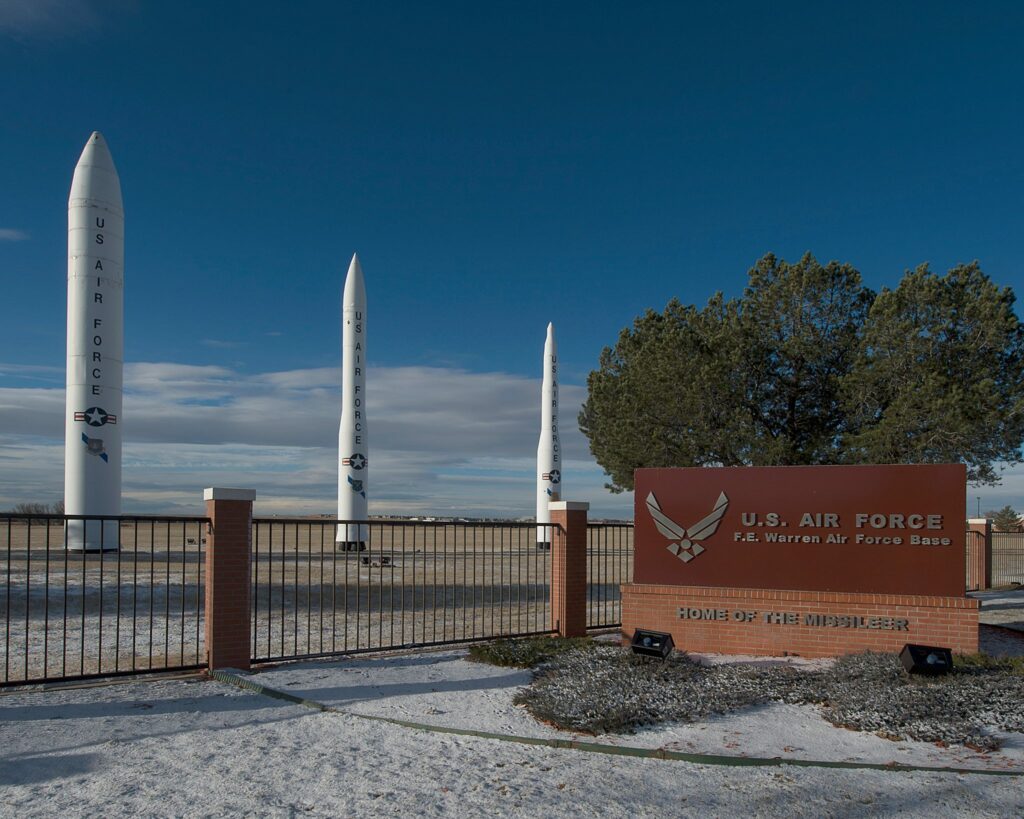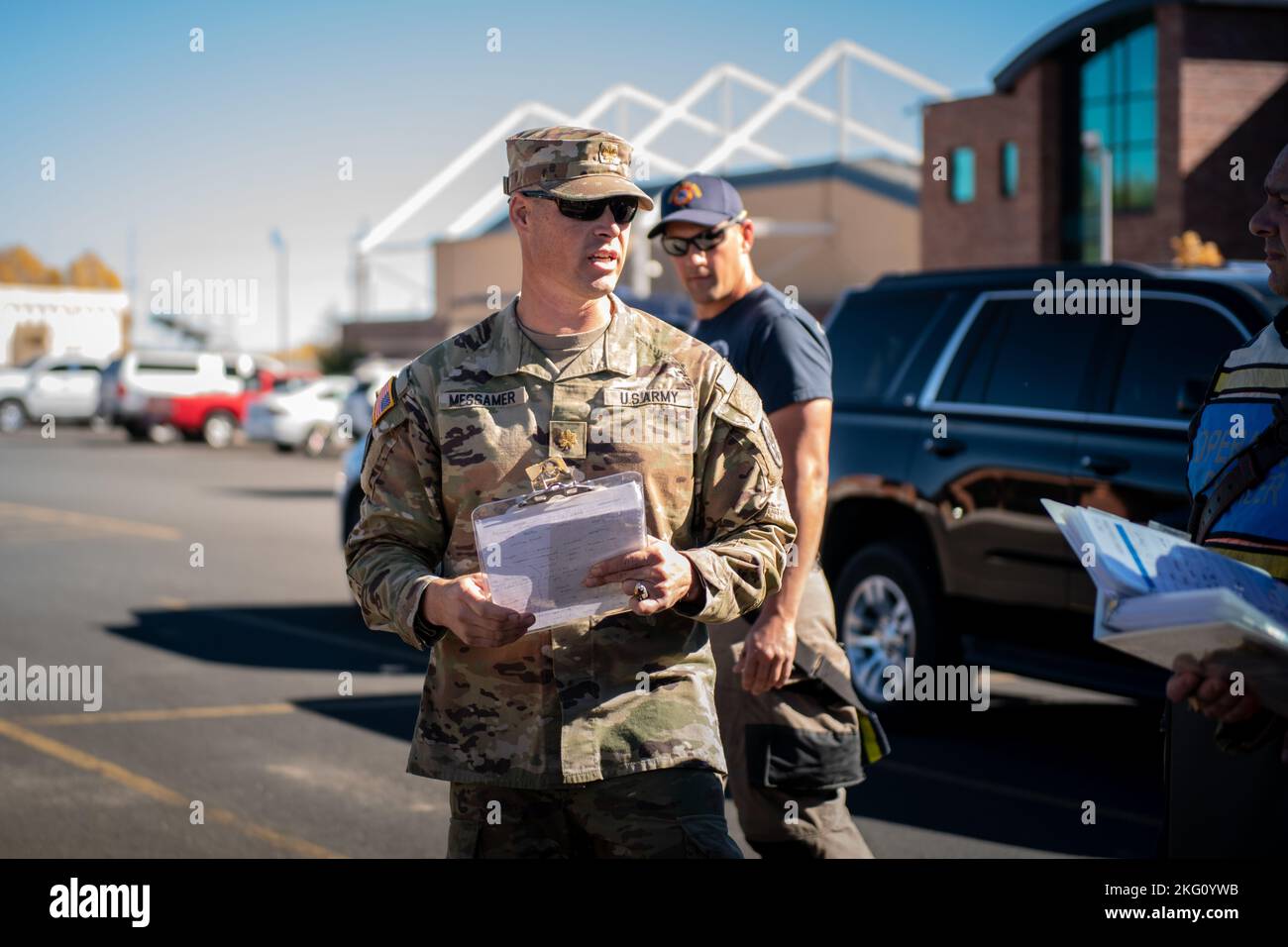Military Bases Wyoming - F.E. Construction has begun on a new nuclear weapons storage facility at Warren Air Force Base. Click image to view full size
F. E. of Cheyenne, Wyoming. The Air Force has opened a new underground nuclear weapons storage and handling facility at Warren Air Force Base.
Military Bases Wyoming

The new Weapons Storage and Maintenance Facility (WSMF; sometimes referred to as the Weapons Manufacturing Facility), which will replace the existing Weapons Storage Facility (WSA), will be a 90,000-square-foot reinforced concrete building with an earth-enclosed facility supporting land structures. . .
Wyoming Air National Guardsmen Work In An Emergency Operations Center In Response To A Simulated Chlorine
A satellite image taken in August and obtained by Maxar shows that the construction of underground facilities and many support facilities is under way.
The Air Force says the new facility will "provide safe and secure storage facilities for the US Air Force (USAF)," referring to the W78/Mk12A and W87/Mk21 Minuteman III ICBM warheads installed in the 150 Warren AFB. Tailed Monsters. In the future, if Congress agrees to fund it, the new W87-1 will replace the W78. According to the Air Force:
"The main interior walls of the storage and storage area are made of 4-foot-thick concrete (RC) and 4-foot-thick RC slabs. The main wall and roof are surrounded by a 20-ft-thick soil layer that includes an RC wall that -3-ft-thick and the roof of the roof material.The heavy multilayered system rests on the RC building's 5-foot-thick mat support.
In 2018, the US Army Corps of Engineers awarded a $144 million contract to Fluor Corporation. A groundbreaking ceremony was held on May 21, 2019, but major construction (of buildings) did not begin until spring 2020. Flor's government team is led by Tom D'Agostino, who previously served as Under Secretary for Nuclear Security at the Department of Energy, Director of the National Nuclear Security Administration (NNSA), and Deputy Director for Defense Systems. Construction will take 40 months and will be completed in 2022.
Cnn Exclusive: Fbi Investigation Determined Chinese Made Huawei Equipment Could Disrupt Us Nuclear Arsenal Communications
F.E. Construction of the underground storage facility at Warren AFB follows the completion in 2012 of a large underground nuclear weapons storage facility at the Strategic Weapons Facility Pacific (SWFPAC) near Kitsap Naval Submarine Base. Underground storage facilities are also proposed for other facilities. The history of nuclear weapons in Wyoming is closely tied to FE Warren Air Force Base, which is associated with the world's development of rocket and nuclear power. If Wyoming were a state, Warren AFB in Cheyenne would make it one of the world's largest nuclear power plants. Wyoming's history with nuclear weapons is tied to Cold War global tensions and the development of missile-based nuclear weapons systems.
The foundation began life at Fort D.A. Russell in 1867. Fort Russell eventually grew into one of the nation's largest cavalry posts. In the late 19th century, it was home to the famous Buffalo Soldiers of three African-American regiments: the 9th and 10th Cavalry and the 24th Infantry.
In 1876, troops from Ft. Russell fought the Sioux in the same battle where General George A. Custer met his end at the Little Big Horn. In 1901, soldiers from the fort were serving in the Philippines. During the Mexican Revolution from 1913 to 1916, artillery units from the fort were stationed on the US-Mexico border.

John "Black Jack" Pershing - later captain, later general of the Army in World War I - Ft. Russell at the moment. Wyoming Senator Francis E. Pershing married Warren's daughter, and the fort was renamed. F.E. Warren AFB was transferred to the Air Force in 1947 and is the oldest continuously operating base in that service branch. (Holland)
Lunch With Airmen
F.E. Warren Air Force Base has no aircraft. However, it is one of the largest missile command bases in the country.
During World War II, Germany launched its first missile attack against England using the infamous V-1 and V-2 rockets. Although US efforts to develop unmanned aircraft had previously failed, Germany's success stimulated new intensive research, eventually producing nearly 5,000 JB-2s (JB for "jet bomb"). These weapons were not ready in time for use against Germany, but work continued on unmanned aerial vehicles and eventually intercontinental ballistic missiles (ICBMs).
After the war, the federal government awarded Convair a contract for a missile that could deliver a 5,000-pound warhead to any target 1,500 to 5,000 miles away. It required great leaping distance and accuracy. The range of the V-2 was only about 200 miles.
Shortly after the atomic bomb was dropped on Hiroshima, the United States Army proposed placing nuclear weapons on missiles. However, this proved to be very difficult to achieve. In November 1952, the US made a breakthrough in thermonuclear research - the hydrogen bomb - which provided a lighter and more powerful warhead. Missile weight can now be reduced, and missiles may be less accurate.
Wyoming Highway Patrol Recognizes Wyoming Military Serving Abroad
The development of missile and nuclear weapons received another boost in the mid-to-late 1950s during the "missile gap" debate, when Democrats claimed—incorrectly, as it turned out—that the Eisenhower administration had allowed the Soviet Union to develop a huge advantage. ICBM numbers. On August 14, 1958, the U.S. In a speech on the floor of the Senate, Massachusetts Senator John F. Kennedy argued that the Eisenhower administration allowed US security to deteriorate. "The most critical years of this gap seem to be 1960-1964 ... our military posture today is measured by the gaps—the missile gap, the space gap, and the small war gap," Kennedy said in his speech. (Goodbye)
At least for missiles, this concern was overblown. Instead of thousands of active missiles, the Soviets actually had only four prototypes. The fear created by these claims spurred spending, accelerated the development of missiles and nuclear weapons, and fueled a nuclear arms race.
Missile and weapon development overcame many technical, administrative, and military obstacles throughout the 1950s. The Air Force has won legal battles to command ballistic missile squadrons. Two ICBMs—the Atlas and the Titan—were used. In August 1957, the Air Force selected Warren Air Force Base as the first operational base for the Atlas and Lowry Air Force Base in Colorado as the first base for the Titan.

The first batch of Atlas missiles were deployed in 1960 F.E. Based in Warren. The missiles were spread across the rich country of southeastern Wyoming, western Nebraska, and northeastern Colorado.
Cheyenne Mountain Complex
Between 1963 and 1965, the Atlas missiles were phased out and replaced by Minuteman I missiles and then Minuteman IIIs between 1972 and 1975.
The deployment of the first 24 Atlas missiles did not cause much controversy in Cheyenne. The base has always been considered a good neighbor in southeast Wyoming, and the missiles and federal spending that came with it provided significant economic growth during years of government decline. Between 1959 and 1965, more than 50,000 people emigrated from Wyoming, a population loss that was affected by excessive births. Things could have been worse if it weren't for the money and military personnel and their families who developed the base as a major center for intercontinental ballistic missiles. (Larson)
Atlas missiles were installed no sooner than the more advanced Minuteman missile began to be released. In 1963, Warren controlled 200 Minuteman 1B missiles spread across the plains of southeastern Wyoming, southwestern Nebraska, and northeastern Colorado. Each missile has a thermonuclear warhead, capable of delivering an explosive force of 1.2 megatons. The weight of the Hiroshima bomb is estimated at 15 kilotons. So the Minuteman warhead packed the power of about 100 Hiroshima bombs.
Warren's first Minuteman missiles were marvels of the time, capable of traveling thousands of kilometers through the atmosphere and delivering bombs within half a mile of a target. They carried the first known onboard computer systems. Strategic nuclear weapons capabilities gradually diverged between the US and the USSR. As the Soviets developed larger bombs, they moved to smaller "throw" units that could be delivered more accurately. The Soviet "most likely" weapon was believed to be a 25 megaton warhead. Most US nuclear weapons were between one-third and one megaton, but even the smallest of them had ten times the power of the Hiroshima bomb.
Wyoming Military Bases
The missiles are placed 170 feet below ground level. Another problem with the Minutemen is that the army can't be completely sure that they will work when they are fired from the cell. "Twice a Year," 1983 by F. The site activation task force command in Warren said, "One of the arrows - we don't know which one - was taken out of its silo and tested at Vandenberg Air Force Base, California. Our success was very good." (Whipple 1983) But then
Military drone range, laser range finder military, military range bags, military range targets, long range military radio, military radio range, military range finder, military long range binoculars, range rover military discount, military range rover, range of military drones, military range bag
0 Comments